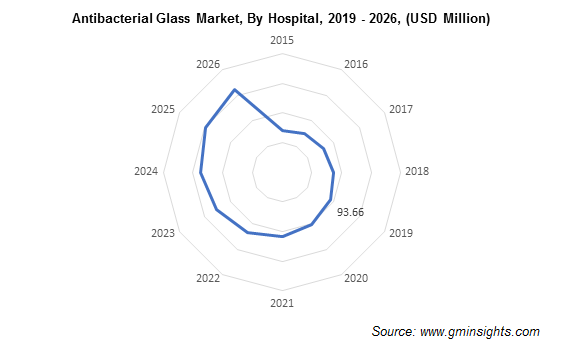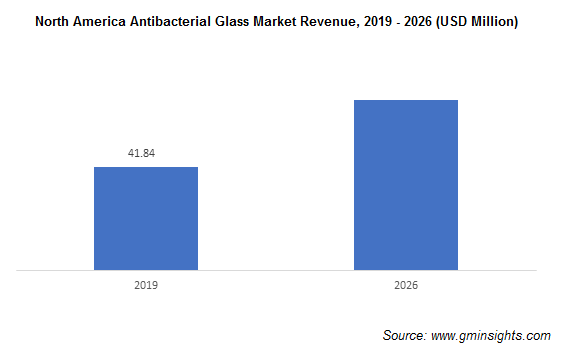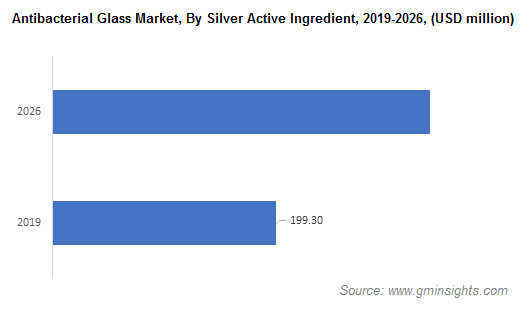Home > Chemicals & Materials > Specialty Glass > Antibacterial Glass Market
Antibacterial Glass Market Analysis
- Report ID: GMI444
- Published Date: Sep 2020
- Report Format: PDF
Antibacterial Glass Market Analysis
The global demand for antibacterial glass containing silver as an active ingredient is likely to surpass USD 335 million by 2026. The silver ions inside the glass performs antimicrobial action and eliminates 99% of all bacteria from the glass surface while also preventing the spread of fungi. When silver ions are diffused into the upper layers of the glass they interact with bacteria and destroy them by disrupting their division mechanism and restricting their metabolism. The antibacterial effect of the glass is ongoing, particularly in warm and moist conditions which are favoring the development of bacteria and mould.
Silver is primarily used active ingredient for manufacturing antibacterial glass owing to its better antibacterial properties and ability to inhibit with chemical bonds present in bacteria. Different silver forms such as silver zeolite, silver nanoparticles and silver salts are used as an active ingredient. These antimicrobial glasses are increasingly used in the manufacturing of wall covering, touchscreen electronic goods, defense equipment and hospitals thereby driving the antimicrobial glass market segment growth.
In addition to silver, copper is also increasingly used on account of its high antimicrobial efficacy, including the ability to destroy the superbugs and pathogens. The antimicrobial efficacy of copper makes them a valuable active ingredient in antibacterial glass manufacturing however, the downsides such as appearance, cost and metallic properties limits its application scope in antibacterial glass market manufacturing.

Global antibacterial glass from hospital applications is likely to grow with CAGR of over 8% through 2026 owing to rising demand for antibacterial products to prevent HAI’s. Increasing adoption and implementation of antimicrobial products in burn units, hematology units and oncology units as they require utmost sanitation is expected to boost the antibacterial glass market growth during forecast period.
Microbial contamination on hospital surfaces lead to infectious processes in hospitalized patients. These problems are minimized by cleaning and disinfecting programs, which use several chemical compounds such as ethanol, sodium hypochlorite, quaternary ammonium salts, and amphoteric surfactants, among others.
The efficiency of these products is influenced by different factors, such as chemical concentration, type and frequency of application among several others. Antibacterial glass eliminates micro-organisms as soon as they come into contact with the surface of the glass resulting into continuous and efficient disinfection of hospital premises thereby augmenting the antibacterial glass market revenue.
The COVID-19 pandemic has exposed the world’s inefficiency in dealing with infectious disease and response capabilities. The spread of COVID-19, increasing establishment of new hospitals and healthcare facilities to deal with COVID-19 across the globe is projected to augment infrastructure development in healthcare industry. Antibacterial glass market forecast is expected to have a crucial role to play as well as will witness a positive demand, with increasing investment in healthcare infrastructure to face the COVID-19 pandemic across several countries over the new few years.

North America demand should surpass USD 65 million by 2026 owing to increasing application scope in food & beverage manufacturing industry. U.S. accounted for the largest market share in North American antibacterial glass market. Food processing companies needs to keep the surfaces sterile to maintain the hygiene and reduce the risk of fungal and bacterial infections to the workers and the consumers through the food.
The presence of large number of food processing companies across the region is projected to boost the demand for antibacterial glass over the forecast period.
An increasing demand for the antibacterial glasses from households to prevent bacteria-related diseases and maintain the overall health and reduce the changes of visiting hospitals during this COVID pandemic is projected to fuel the antibacterial glass market growth from the region. Places such as bathrooms and washrooms in the homes that are damp are more likely to augment the growth of bacteria.
With the rise in disposable income and the improving standard of living of the urban population there is an increasing use of antibacterial glass in the households which will fuel the product demand in North American market.
Antibacterial glass consists of active ingredients such as silver, copper among others which are the metallic ions of costly metals. These active ingredients increase the cost of antibacterial glass for their applications in hospitals, food & beverage industries, households as larger surfaces need to be cover with them. The high cost of silver is limiting the implementation in the healthcare sector.
In addition to that, cost associated with R&D will further increase the cost of antibacterial glass for application industries. Presence of several other alternatives such as the antibacterial sheets are expected to be used as antimicrobial products considering its high effectiveness and low cost in inhibiting the growth of bacteria is another major factor hampering the antibacterial glass market growth.

